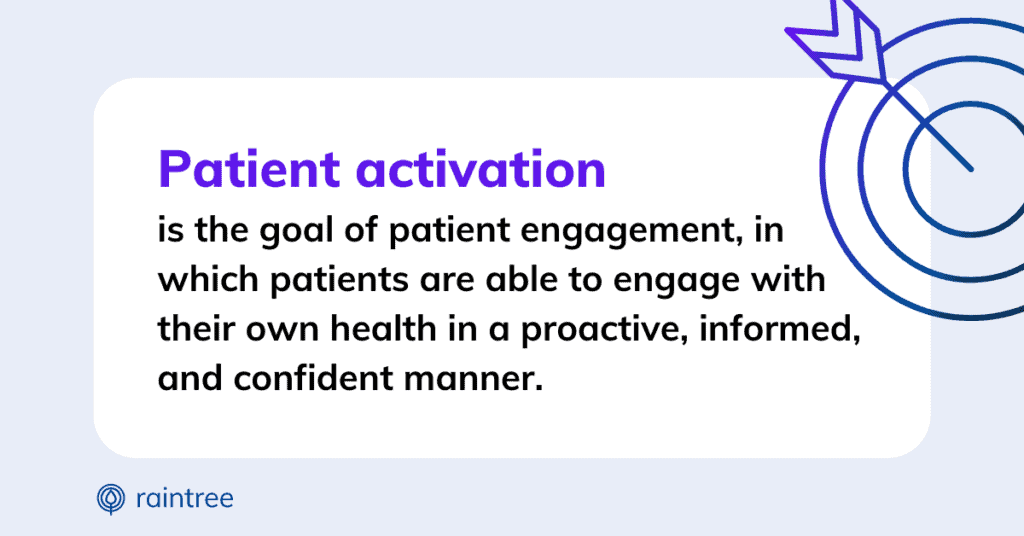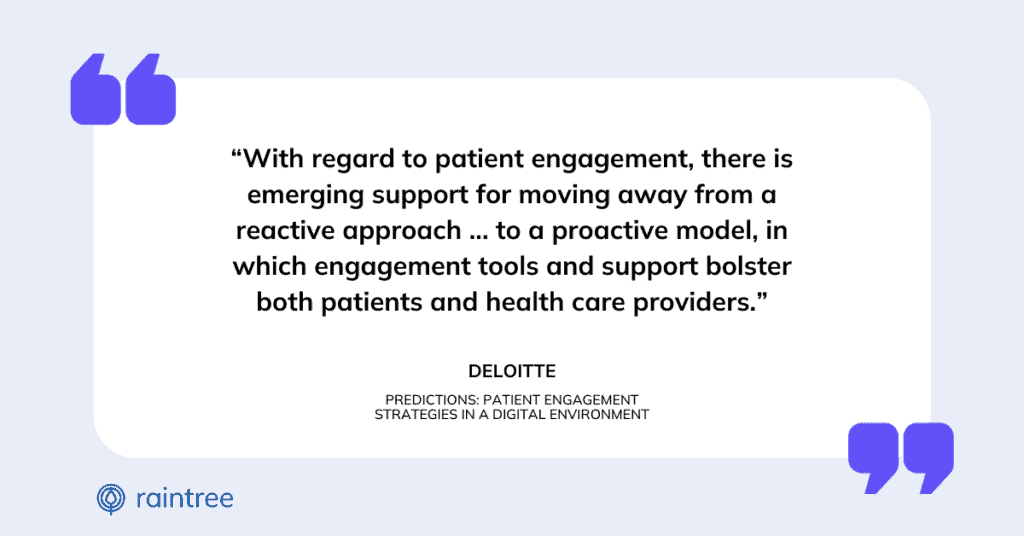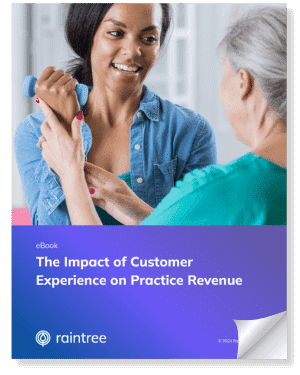Patient engagement is a crucial aspect of running a successful outpatient practice.
Engaging patients can lead them to take an active role in managing their health and can lead to better treatment outcomes. There are various tried-and-true strategies to engage patients, but many providers struggle to find an approach that really resonates.
Creativity can help you connect with patients on a more personalized level—and we’re here to show you how, with three successful patient engagement strategies.
What is Patient Engagement?
Simply put, the term “patient engagement” refers to the process of involving patients in their own healthcare decisions and treatments. This includes empowering patients to take an active role in managing their health, providing them with education about their conditions, and involving them in developing treatment plans. Patient engagement has been shown to improve health outcomes, increase patient satisfaction, and reduce healthcare costs over time.
What it’s not: Expecting patients to be engaged, enthusiastic, and informed all on their own. If the patient-provider relationship is a two-way street, make a roadmap! Providing patient-centric care means offering supportive resources and opportunities for engagement at every stage of the patient journey.
Why Is Patient Engagement Important?
Yes, you probably know that patient engagement is important. But do you know why? Next-level engagement strategies and tools can honestly transform the overall experience at your practice.
These are a few important targets of a comprehensive patient engagement campaign:
Patient Satisfaction
When patients actively participate in their care decisions, they have a greater sense of control and investment in their own outcomes. Plus, engaged patients tend to feel more satisfied with their treatment. Satisfied patients can create higher Net Promoter Scores (NPS) and turn patients super fans!
Better Health Outcomes
How does patient engagement translate to treatment adherence? When you let patients participate in decision-making, they’re more likely to understand, follow, and benefit from personalized treatment plans or Home Exercise Programs (HEP).
Stronger Patient-Provider Trust
Engaged patients and providers have open lines of communication, fostering shared decision-making. Patients who trust their providers will feel more comfortable asking questions, expressing concerns, and giving honest feedback.
Stable Revenue
With the shift to value-based care and Merit-Based Incentive Payment Systems (MIPS), adopting a patient-centric approach has a direct impact on reimbursements and revenue. Additionally, retaining patients in care can lead to a greater customer lifetime value (CLV).
Clinical Efficiency
A solid patient engagement strategy will help patients help themselves. Patient engagement tools can provide easy access to health information and automate patient communications. As a result, staff and patients can make the most use of their time in the clinic!
Patient Activation: How to Identify Engaged Patients
Patient engagement should lead to people feeling empowered, educated, and, ultimately, activated.
Have you heard the phrase “patient activation” before? If you haven’t, you might be saying, “Wait up. What is patient activation, exactly? Is it different from patient engagement?”
“Patient activation” is the goal or endpoint of patient engagement. It means that your patients are able to engage with their own health in a proactive, informed, and confident manner.
There are multiple levels of patient activation, defined by the aptly-named Patient Activation Measure (PAM):
- Believing the patient role is important. At this stage, patients may be feeling overwhelmed, confused, or disempowered. They know they have an issue and know that they lack the tools or expertise to manage it on their own. Immediate needs may include scheduling a new appointment or being referred to a specialist for care.
- Having the confidence and knowledge necessary to take action. Once patients have sought out your help, it’s time to educate and empower. At this stage, that patient needs crystal-clear instruction regarding diagnosis, prescriptions, lifestyle adjustments, or HEPs. Charting an actionable path forward builds confidence.
- Actually taking action to maintain and improve one’s health. Knowing the steps forward doesn’t mean every patient will take them. At this stage, patients will need supportive resources and encouragement–and this may look different for each individual. Patient engagement strategies can foster accountability.
- Staying the course even under stress. Treatment isn’t a cake walk–especially in the rehabilitation therapy field. To reach self-determination, patients will need to be able to stick to their treatment despite challenges. This may require additional encouragement, or even considering how your practice can remove barriers to continuous care.

Trends in Patient Engagement
Like any other aspect of patient care, engagement strategies must evolve over time. A few ways to develop a proactive patient engagement strategy are to:
- Keep an eye on broad trends in patient attitudes. For example, in a 2020 survey conducted by The Advisory Board, “56% [of respondents] were more interested in managing their underlying conditions [after Covid-19 emerged] than prior to the pandemic.” Knowing the influence of local, international, or cultural factors can inform your strategy. There’s no reason to appear out-of-touch!
- Encourage shared decision-making. Approach treatment as a partnership, not a product. Your practice can proactively seek out clinical strategies like the SHARE approach, which combines evidence-based care with patient input, or engaging patient advisors in practice operations. Open dialogue equals invaluable insight!
- Seek opportunities to digitize, automate, and modernize patient engagement. Technology can’t do everything. But it can make our lives easier! For example, implementing automatic, HIPAA-compliant appointment reminders via text can reduce accidental no-shows. No-shows are no fun, for anyone.
So, now you know how staying on top of trends and technologies can help your practice connect with patients. But let’s not get too far ahead of ourselves! There are plenty of tried-and-true patient engagement techniques to explore.
Common Strategies to Create More Engaged Patients
Patient engagement is a multifaceted endeavor that spans the patient journey. As such, there are many proven techniques that you can put into place, like:
- Referral and lead tracking. Patient engagement can begin even before they’re technically your patient! Pro tip: Use eReferrals and automated communications to turn referrals into patients, faster!
- Using patients’ preferred communication channels. During patient intake, collect patient communication preferences (e.g. text, email, or voicemail).
- Family engagement. Don’t underestimate the value of family in treatment adherence and personalization. This may be intuitive in specialties like pediatric therapy, but adults and seniors can benefit from family- and community-involved care, too.
- Promoting your patient portal. According to an ONC medical records report, only 38% of patients would access their medical records online on their own. When prompted to use their patient portal, that number jumped up to 63%!
- Digital-first touchpoints. From providing two-way communication tools, to telehealth and remote therapeutic monitoring, you can provide care beyond the clinic walls.
- Gather feedback. In addition to shared decision-making, your practice can engage patients with Net Promoter Score (NPS) surveys to assess engagement throughout care.
- End-to-end patient engagement strategies. This can look like appointment reminders between visits, or even health education campaigns after patients have been discharged. Aftercare can support continued health and keep your practice top-of-mind.

Challenges in Modern Patient Engagement
What do you do when a patient just isn’t invested in their health? Some days, it may seem like your advice goes in one ear and out the other.
In physical therapy, for example, it’s easy to know when a patient skipped all their home exercises. It can be incredibly frustrating or demoralizing, and can even contribute to provider burnout. With that in mind, our advice might be a hard pill to swallow, at first:
Try to let go of your assumptions.
There are plenty of issues that could stop a patient from being fully engaged in their own care. Some are unavoidable, but others can be addressed on an individual or organizational level.
Challenges in patient engagement include:
- Communication. You can’t empower patients with knowledge if it’s vague or confusing. Make a policy to explain everything in detail, then ask if patients have any questions. Note: Communication issues can also include language barriers!
- Health literacy. This is defined as “the degree to which individuals have the capacity to obtain, process, and understand basic health information and services needed to make appropriate health decisions.” About a third of Americans have low health literacy, so don’t assume every patient will “get” clinical terms or concepts.
- Social determinants of health. These are the conditions and environments that affect patients’ health and quality-of-life (e.g. education, economic stability, or social factors). These can be complex and interrelated–and often out of the patient’s control–which underlines the importance of personalized care.
- Patient trust. Trust is essential! When a patient feels like “just a number” or fears judgment, discrimination, or exploitation, their treatment will suffer. The practice and the provider are responsible for creating an environment where patients feel safe and prioritized.
When you’re facing these challenges, it may be time to get creative with your approach.
Get the Newsletter!
Key rehab therapy insights and resources. Twice a month. Unsubscribe any time.
3 Examples of Creative Patient Engagement Strategies
Patients are people too. They have a lot going on. When building up patient engagement strategies at your practice, you may need to get creative to cut through the noise.
Here are a few examples of creative patient engagement strategies in healthcare:
1. Get Personal on Social Media
The Strategy: In 2023, most practices have social media. But not all of them use it effectively. The pharmaceutical manufacturer, Pfizer, was an early adopter of social media for patient engagement when they launched the “Can You Feel My Pain?” campaign in 2011. In this campaign to engage people living with chronic pain, Pfizer encouraged individuals to sign an online petition and share their chronic pain stories on Facebook, Twitter, and Flikr. Before launching, the campaign designers monitored social media conversations regarding chronic pain and consulted with patient advocates to better understand their audience.
The Result: In the months after launching the campaign, “Can You Feel My Pain?” generated over 1,100 personal stories and photos on social media, and over 1,700 petition signatures. And this was just a pioneering example. With the rapid growth of social media platforms and viral marketing over the past decade, even more is possible in 2023!
The Take-away: Build trust by truly listening to your patients. Vera Rulon, Pfizer’s Director of External Medical Communications, said this: “There really is no one strategy for driving patient engagement; it’s a combination of listening to patients, leveraging digital communications, and finding solutions and treatments that meet their needs.”
2. Use Fresh Ideas from Unexpected Sources
The Strategy: Have you ever asked your staff to come up with creative ideas for patient engagement? It’s time to start! In 2019, the Agency for Healthcare Research and Quality (AHRQ) presented a study on the impact of staff creativity on the patient experience. During an 18-month-long initiative, they asked 72 providers from 12 health centers to participate on a Quality Improvement team focused on the patient experience. During monthly meetings, they would discuss, debate, and create plans to implement the ideas that emerged.
The Result: The Quality Improvement team came up with a total of 220 ideas, which were then rated for novelty and usefulness. The health centers that implemented the most creative ideas were associated with improved care coordination and provider rating scores. Interestingly, “dissatisfied” staff were the ones who came up with the highest-creativity ideas.
The Take-away: Great ideas are right under your nose! Don’t dismiss the creative potential of your staff, especially those who may seem less engaged. These providers may be more willing to step outside the box–and their ideas can achieve great results. Bring them into the process by encouraging internal feedback.
3. Drive Engagement by Minimizing Barriers to Care
The Strategy: Lack of transportation is a social determinant of health, which can prevent patients from taking steps in their own care. In 2016, the MedStar Institute of Innovation launched a program in partnership with popular ride-share app, Uber, to help patients in underserved communities access hospital care. To engage patients in need, MedStar added a “Ride with Uber” button to their site.
The Result: Since the program began, MedStar patients have taken more than 1,500 rides to medical appointments through the service. Director of Consumer Health Initiatives, Pete Celano, found that “many patient no-shows, cancellations and reschedules [were] because patients lack[ed] convenient or cost-effective transportation.”
The Take-Away: Get to know your patients’ barriers to care. For MedStar, investing in patient transportation led to greater engagement in care and fewer no-shows. For your practice, it could mean offering telehealth, creating affordable payment plans, or another unique patient engagement strategy tailored to your patients’ needs!
Finding the Best Tools for Patient Engagement
If you’re struggling to engage, retain, and impress your patients, it’s time to make a change. Choosing the right solution is the key to effective, creative patient engagement strategies.
Here at Raintree Systems, we help physical therapy, occupational therapy, speech-language pathology and multi-disciplinary practices grow and succeed with scalable and robust software solutions, from our electronic health records (EHR) system to a robust suite of patient engagement tools. Want to learn more? Schedule a demo and learn why high-growth PT, OT, SLP, and multi-disciplinary practices choose Raintree.
Read the eBook:
The Impact of Customer Experience on Practice Revenue



